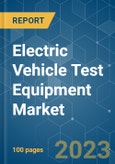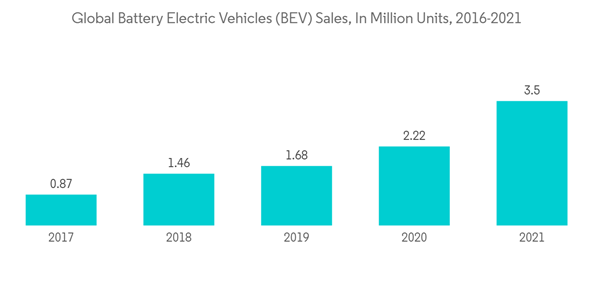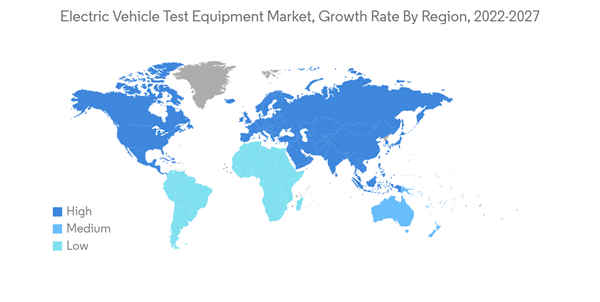Currently, the electric vehicle test equipment market is valued at USD 43.51 million and is expected to reach USD 98.73 million over the next five years at a CAGR of 17.8%.
In May, 2022, HORIBA announced the expansion of its Leichlingen branch in North Rhine-Westphalia, and the official completion and commissioning of its new facility in Magdeburg-Barleben in Saxony-Anhalt were made public. With a USD 38 million investment, the new headquarters of HORIBA FuelCon GmbH, a wholly-owned subsidiary of HORIBA Europe GmbH and the global center of excellence for fuel cells, batteries, and electrolyzers within the HORIBA Group, is located in the new company building known as 'eHUB' in the Technologiepark Ostfalen in Magdeburg-Barleben.
This product will be delivered within 2 business days.
Key Highlights
- The electric vehicle test equipment industry is experiencing uncertainty due to the COVID-19 crisis. Industries have been temporarily or completely shut down by various regions' governments, which has had a negative impact on sales and production as a whole. It also caused flight cancellations, travel bans, and quarantines, which significantly slowed global logistics and supply chain operations.
- Over the past few years, the electronic and automotive industries have undergone significant changes. Higher power, high-energy power conversion systems, and advanced powertrain systems are required to meet the growing demand for advanced automotive applications and safety features like navigation systems, infotainment systems, adaptive cruise control systems, and electronic ignition systems. In addition, the production of advanced electric vehicle test equipment with programmable power sources and electronic loads with higher power and faster response time is a result of this driving innovation.
- Over the long term, owing to the crucial step in the testing of electric vehicles, conformance testing of all electrical components like plugs, cables, connectors, wiring, and switches, the market is expected to grow as engineers should address new testing difficulties as transportation zap speeds up. The traditional nominal voltage and power levels of 300/400VDC are being replaced by 800/1000VDC, with transients reaching 1200V. These higher voltages enable faster charging, increased power transfer, and lighter vehicles. These elements are impelling progressions in superior execution batteries, drivetrains, power converters, inverters, and quicker chargers.
- Customers want modular test solutions with expandable power, integrated safety, larger operating envelopes, integrated measurements, and faster transient response times for current products. As a result, advanced test solutions have been developed that support the growth of the electric vehicle test equipment market over the anticipated time period by reducing development and testing times, decreasing costs, and increasing energy efficiency.
Electric Vehicle Test Equipment Market Trends
Increased Electric Vehicle Adoption Globally
- The market is being driven by increased sales of BEVs and PHEVs, as well as lower costs for powertrain components due to material advancements and improved packaging arrangement. In addition, the high cost of batteries has necessitated enhancements to vehicle performance and power electronics.
- In addition, various programs and policies have been implemented by governments worldwide to encourage consumers to choose electric vehicles over conventional ones. The California ZEV program, which aims to have 1.5 million electric vehicles on the road by 2025, is one such initiative that encourages the purchase of electric vehicles. India, China, the United Kingdom, South Korea, France, Germany, Norway, and the Netherlands are additional nations that provide various incentives.
- After COVID-19 spread, sales of electric vehicles increased significantly. Lockdowns imposed by governments all over the world have slowed the economy and hurt sales of electric vehicles and charging infrastructure systems. The availability of additional components, such as inverters and lithium-ion battery packs, was affected. An integral component of electric vehicles is a power inverter. It uses a traction motor to propel the vehicle by converting energy from the batteries.
- Manufacturers of electric vehicles have faced a significant challenge in gaining consumer acceptance. Due to factors such as a lack of charging infrastructure and the high cost of electric vehicles (electric vehicle costs are almost the same as those of entry-level luxury cars), consumers have been reluctant to purchase electric vehicles despite the benefits they provide. Due to COVID-19, a number of nations, including India, put their plans to construct over 50,000 charging stations and improve the charging infrastructure on hold.
- Significantly, a number of OEMs intend to restructure their product lines solely to produce electric automobiles. For instance, General Motors announced in 2021 that by 2025, it would spend USD 20 billion on electric and autonomous vehicles. By 2023, the company intends to introduce 20 new electric models and sell more than 1 million electric cars annually in China and the United States.
- By 2024, Volkswagen intends to invest USD 36 billion in electric vehicles across its mass-market brands. The business claims that by 2025, electric vehicles will account for at least 25% of its global sales.
Asia-Pacific is Leading the Market
- The market is being driven by increased sales of BEVs and PHEVs, as well as lower costs for powertrain components due to material advancements and improved packaging arrangement. In addition, the high cost of batteries has necessitated enhancements to vehicle performance and power electronics.
- In addition, various programs and policies have been implemented by governments worldwide to encourage consumers to choose electric vehicles over conventional ones. The California ZEV program, which aims to have 1.5 million electric vehicles on the road by 2025, is one such initiative that encourages the purchase of electric vehicles. India, China, the United Kingdom, South Korea, France, Germany, Norway, and the Netherlands are additional nations that provide various incentives.
- After COVID-19 spread, sales of electric vehicles increased significantly. Lockdowns imposed by governments worldwide have slowed the economy and hurt sales of electric vehicles and charging infrastructure systems. The availability of additional components, such as inverters and lithium-ion battery packs, was affected. An integral component of electric vehicles is a power inverter. It uses a traction motor to propel the vehicle by converting energy from the batteries.
- Manufacturers of electric vehicles have faced a significant challenge in gaining consumer acceptance. Due to factors such as a lack of charging infrastructure and the high cost of electric vehicles (EV costs are almost the same as those of entry-level luxury cars), consumers have been reluctant to purchase electric vehicles despite the benefits they provide. Due to COVID-19, a number of nations, including India, had to put their plans to construct over 50,000 charging stations and improve the charging infrastructure on hold.
- Significantly, a number of OEMs intend to restructure their product lines solely to produce electric automobiles. For instance, General Motors announced in 2021 that by 2025, it would spend USD 20 billion on electric and autonomous vehicles. By 2023, the company intends to introduce 20 new electric models and sell more than 1 million electric cars annually in China and the United States.
- By 2024, Volkswagen intends to invest USD 36 billion in electric vehicles across its mass-market brands. The business claims that by 2025, electric vehicles will account for at least 25% of its global sales.
Electric Vehicle Test Equipment Market Competitor Analysis
National Instruments Corporation, Horiba Ltd., Arbin Instruments, Maccor Inc., Keysight Technologies, Inc., Durr Group, TUV Rheinland, and others are among the key players in the Electric Vehicle Test Equipment Market. The market is gaining traction due to the expansion of key players. For instance,In May, 2022, HORIBA announced the expansion of its Leichlingen branch in North Rhine-Westphalia, and the official completion and commissioning of its new facility in Magdeburg-Barleben in Saxony-Anhalt were made public. With a USD 38 million investment, the new headquarters of HORIBA FuelCon GmbH, a wholly-owned subsidiary of HORIBA Europe GmbH and the global center of excellence for fuel cells, batteries, and electrolyzers within the HORIBA Group, is located in the new company building known as 'eHUB' in the Technologiepark Ostfalen in Magdeburg-Barleben.
Additional benefits of purchasing the report:
- The market estimate (ME) sheet in Excel format
- 3 months of analyst support
This product will be delivered within 2 business days.
Table of Contents
1 INTRODUCTION
4 MARKET DYNAMICS
5 MARKET SEGMENTATION
6 COMPETITIVE LANDSCAPE
Companies Mentioned (Partial List)
A selection of companies mentioned in this report includes, but is not limited to:
- National Instruments Corporation
- Horiba Ltd.
- Arbin Instruments
- Maccor Inc.
- Keysight Technologies, Inc.
- Froude, Inc.
- Dynomerk Controls
- Durr Group
- Tuv Rheinland
- Intertek Group Plc
- Toyo System Co., Ltd
- Wonik Pne Co., Ltd
Methodology

LOADING...










